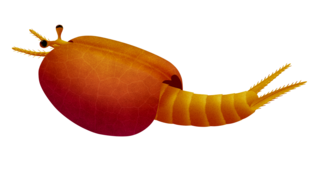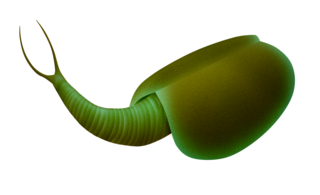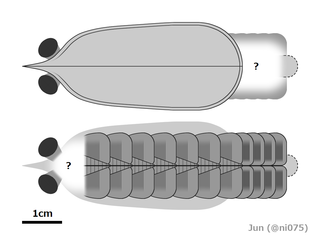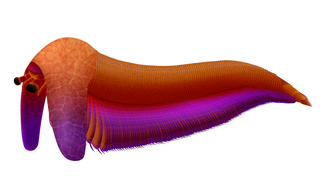
The lobopodians, members of the informal group Lobopodia, or the formally erected phylum Lobopoda Cavalier-Smith (1998), are panarthropods with stubby legs called lobopods, a term which may also be used as a common name of this group as well. While the definition of lobopodians may differ between literatures, it usually refers to a group of soft-bodied, worm-like fossil panarthropods such as Aysheaia and Hallucigenia.

Opabinia regalis is an extinct, stem group arthropod found in the Middle Cambrian Burgess Shale Lagerstätte of British Columbia. Opabinia was a soft-bodied animal, measuring up to 7 cm in body length, and its segmented trunk had flaps along the sides and a fan-shaped tail. The head shows unusual features: five eyes, a mouth under the head and facing backwards, and a clawed proboscis that probably passed food to the mouth. Opabinia probably lived on the seafloor, using the proboscis to seek out small, soft food. Fewer than twenty good specimens have been described; 3 specimens of Opabinia are known from the Greater Phyllopod bed, where they constitute less than 0.1% of the community.

Sanctacaris is a Middle Cambrian arthropod from the Burgess Shale of British Columbia. It was most famously regarded as a stem-group chelicerate, a group which includes horseshoe crabs, spiders and scorpions, although subsequent phylogenetic studies have not always supported this conclusion. Its chelicerate affinities regain support in later observations, alongside the reassignment of Habelia optata as a sanctacaridid-related basal chelicerate. It has been placed as a member of the extinct family Sanctacarididae alongside Wisangocaris and Utahcaris.

Anomalocaris is an extinct genus of radiodont, an order of early-diverging stem-group arthropods. The first fossils of Anomalocaris were discovered in the Ogygopsis Shale of the Stephen Formation in British Columbia, Canada by Joseph Frederick Whiteaves, with more examples found by Charles Doolittle Walcott in the Burgess Shale unit of the Stephen Formation. Other closely related fossils have been found in the older Emu Bay Shale of Australia, as well as possibly elsewhere. Originally several fossilized parts discovered separately were thought to be three separate creatures, a misapprehension corrected by Harry B. Whittington and Derek Briggs in a 1985 journal article. With a body length close to 40 centimetres, A. canadensis is thought to be one of the earliest examples of an apex predator, though others have been found in older Cambrian lagerstätten deposits.

Canadaspis is an extinct genus of bivalved Cambrian arthropod, known from North America and China. They are thought to have been benthic feeders that moved mainly by walking and possibly used its biramous appendages to stir mud in search of food. They have been placed within the Hymenocarina, which includes other bivalved Cambrian arthropods.

Waptia fieldensis is an extinct species of arthropod from the Middle Cambrian Burgess Shale Lagerstätte of Canada. It grew to a length of 6.65 cm (3 in), and had a large bivalved carapace and a segmented body terminating into a pair of tail flaps. It was an active swimmer and likely a predator of soft-bodied prey. It is also one of the oldest animals with direct evidence of brood care. Waptia fieldensis is the only species classified under the genus Waptia. Other specimens of Waptia are known from the Spence Shale in Utah.

Perspicaris an extinct genus of bivalved arthropod from the Cambrian period. Fossils have been found in North America, primarily the Burgess Shale of British Columbia, Canada but also possibly the Wheeler Shale, Marjum Formation, Pioche Shale and Bloomington Formation. Two named species are known from the Burgess Shale Perspicaris dictynna and Perspicaris recondita, which differ in maximum size, as well as proportions of the tail. Both species have a pair of stalked eyes, as well as a pair of large segmented antennae. The tail is forked and spiny. They are thought to have been active swimmers (nektonic).

Odaraia is a genus of bivalved arthropod from the Middle Cambrian. Its fossils, which reach 15 centimetres (5.9 in) in length, have been found in the Burgess Shale in British Columbia, Canada.
A number of assemblages bear fossil assemblages similar in character to that of the Burgess Shale. While many are also preserved in a similar fashion to the Burgess Shale, the term "Burgess Shale-type fauna" covers assemblages based on taxonomic criteria only.

Tuzoia is an extinct genus of large bivalved arthropod known from Early to Middle Cambrian marine environments from what is now North America, Australia, China, Europe and Siberia. The large, domed carapace reached lengths of 180 millimetres (7.1 in), making them amongst the largest known Cambrian arthropods.

Plenocaris plena is a Cambrian arthropod with a bivalved carapace, and is known from the Burgess shale and Chengjiang. Originally described as a species of Yohoia by Walcott in 1912, it was placed into its own genus in 1974.

Haikoucaris is a genus of megacheiran arthropod that contains the single species Haikoucaris ercaiensis. It was discovered in the Cambrian Chengjiang biota of China.

Isoxys is a genus of extinct bivalved Cambrian arthropod; the various species of which are thought to have been freely swimming predators. It had a pair of large spherical eyes, and two large frontal appendages used to grasp prey.

Radiodonta is an extinct order of stem-group arthropods that was successful worldwide during the Cambrian period. They may be referred to as radiodonts, radiodontans, radiodontids, anomalocarids, or anomalocaridids, although the last two originally refer to the family Anomalocarididae, which previously included all species of this order but is now restricted to only a few species. Radiodonts are distinguished by their distinctive frontal appendages, which are morphologically diverse and used for a variety of functions. Radiodonts included the earliest large predators known, but they also included sediment sifters and filter feeders. Some of the most famous species of radiodonts are the Cambrian taxa Anomalocaris canadensis, Hurdia victoria, Peytoia nathorsti, Titanokorys gainessii, Cambroraster falcatus and Amplectobelua symbrachiata, the Ordovician Aegirocassis benmoulai and the Devonian Schinderhannes bartelsi.

Protocaris marshi is an extinct species of bivalved arthropod known from a single specimen collected from the Cambrian Series 2 aged Parker Formation from the Parker Quarry of northwestern Vermont, United States The specimen is preserved in top-down view and has a bivalved carapace, a segmented trunk and a forked tail. Its precise taxonomic position is uncertain, due to the limited nature of known remains, but it is suggested to be a member of Hymenocarina belonging to the family Protocarididae, which also includes Tokummia and Branchiocaris.

Tokummia katalepsis is a fossil hymenocarine arthropod from the Burgess Shale as found in a quarry in Marble Canyon in Canada, lived during middle Cambrian. The animal has maxillipeds, mandibles, ring-shaped around 50 body segments, and subdivided basipods. At the front of the animal, there are a pair of antennae, possible eyes and mandibles with pincers. Tokummia shows the oldest record of arthropod pincers. Carapaces had length up to 8.78 cm (3.46 in) long. Its biramous legs had endites. It is suggested to be a bottom feeder, being able to walk on the sea floor, and to occasionally swim, and used its pincers to catch prey.

Hymenocarina is an order of extinct arthropods known from the Cambrian. They possess bivalved carapaces, typically with exposed posteriors. Members of the group are morphologically diverse and had a variety of ecologies, including as filter feeders and as predators. Recent research has generally considered them to be stem or crown group members of Mandibulata, due the presence of mandibles in at least some species.

Erratus is an extinct genus of marine arthropod from the Cambrian of China. Its type and only species is Erratus sperare. Erratus is likely one of the most basal known arthropods, and its discovery has helped scientists understand the early evolution of arthropod trunk appendages. Some of the stem-arthropods like radiodonts did not have legs, instead they had flap like appendages that helped them swim. Erratus on the other hand had not only flaps but also a set of primitive legs. It also supported the theory that the gills of aquatic arthropods probably evolved into the wings and lungs of terrestrial arthropods later in the Paleozoic.

Balhuticaris is a genus of extinct bivalved hymenocarine arthropod that lived in the Cambrian aged Burgess Shale in what is now British Columbia around 506 million years ago. This extremely multisegmented arthropod is the largest member of the group, and it was even one of the largest animals of the Cambrian, with individuals reaching lengths of 245 mm (9 in). Fossils of this animal suggests that gigantism occurred in more groups of Arthropoda than had been previously thought. It also presents the possibility that bivalved arthropods were very diverse, and filled in a lot of ecological niches.

Jugatacaris is an extinct genus of bivalved arthropod known from a single species, Jugatacaris agilis found in the Cambrian Stage 3 aged Chengjiang biota of Yunnan, China. The carapace is around 28 to 37 millimetres in length, with a pronounced ridge at the top of the carapace separating the two valves, which formed a fin-like structure raised above the carapace. The head has a pair of stalked eyes, as well as a dumbbell shaped medial eye between them. The head also bore a pair of mandibles as well as at least one and possibly two pairs of antennules. The trunk had up to 65 segments, each with biramous appendages. The appendages had thin endopods with 30 podomeres, each bearing a spiny endite, with the endopods ending with a terminal claw. The appendages also had overlapping flap-like exopods, which are elongated, being at maximum eight times as long as they are wide, which on their posterior edge are covered with setae. The trunk ended with a forked tail. It was likely an actively swimming filter feeder, using its constantly beating appendages to sift food from the water column, which was then passed forward along the U-shaped food groove between the appendage pairs towards the mouth. While initially placed as a crustaceanomorph, later studies considered to be a member of Hymenocarina, which contains numerous other similar bivalved Cambrian arthropods.




















